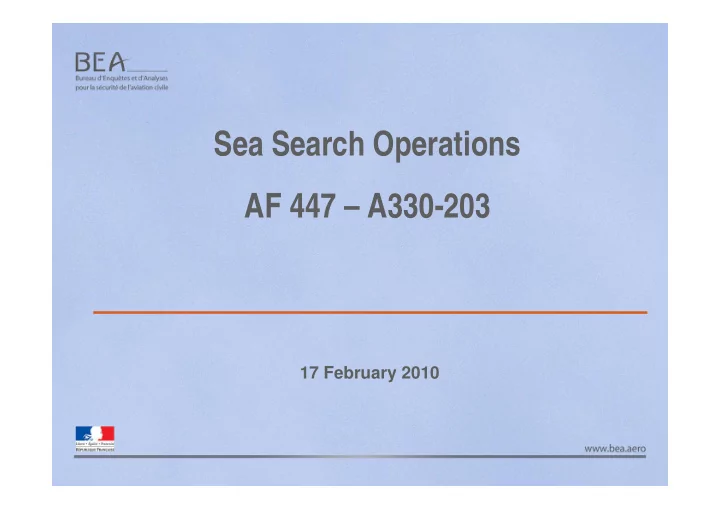

Sea Search Operations AF 447 – A330-203 17 February 2010
Search Phases • Phase 1 : Acoustic search for Underwater Locator Beacons (10 June to 10 July in the search zone) • Phase 2 : Search for the wreckage using a towed array SONAR (27 July to 17 August in the search zone) • Preparations for Phase 3: Establishment of international group (AAIB, BFU, CENIPA, MAK, NTSB, SG Mer, US Navy) • Determination of the search zone • International call for tenders and selection of means
Determination of the Search Zone
A Scientific Challenge • The sea area is turbulent, the currents are rapidly variable, which makes it difficult to generate models, • Oceanic general circulation models in operational mode do not reproduce the available current observations (phases 1&2), • It is necessary to have additional current measurements to overcome this problem, • Time management in relation to the operational constraints.
Un enjeu scientifique • La zone est turbulente, les courants rapidement variables, ce qui rend leur modélisation délicate, • les modèles de la circulation générale océanique dans leur mode opérationnel ne reproduisent pas les observations de courant disponibles (phases 1&2), • il est nécessaire de disposer de mesures de courant supplémentaires pour dépasser cette situation, • gestion du temps en fonction des contraintes opérationnelles.
Constitution of the Group • Objective: broaden the range of skills available. • Call for international cooperation • Calling on additional expertise in the fields of: – Collection and analysis of data, – Re-analyzing meteorological data, – Re-analyzing (and re-processing) oceanographic data, – Theoretical research, – Statistics.
Group Members • Société Collecte Localisation Satellites (France), • Ecole Normale Supérieure (France), • Laboratoire de Physique des Océans / IFREMER (France), • Laboratoire de Physique des Océans / CNRS (France), • Institut de Mathématiques de Toulouse (France), • Institute of Numerical Mathematics of the Russian Academy of Sciences (Russian Federation), • Mercator Océan (France), • Météo-France (France), • National Oceanography Center (United Kingdom), • Service Hydrographique et Océanographique de la Marine (France), • Woods Hole Oceanographic Institution (United States).
Group Tasks • Widen collection and analysis of data • Improve estimation of currents • Estimate errors in drift calculations • Propose a search zone
Widen collection and analysis of data • Observations of currents , • 5 different wind models, • Data relating to the debris (initial information on 5 June), • Sattellite data (temperature, colour of water, water height anomaly de), • etc.
Improve Estimation of Currents Complementary approaches: • a posteriori validation of data and implementation of refined models, • assimilation of observations on the currents, • methods to interpolate observations. Examples of results
Estimated currents on 5 June at 18h by the optimal interpolation method
Estimate Errors in Drift Calculations • Estimation of the models’ capacity to recreate the trajectories: - tests on trajectories of buoys, - modelling of the debris dispersion, • Sensitivity of the models’ results to forcing by the wind, • Sensitivity to the initial conditions, • Uncertainty of the effect of the wind on the submerged parts of the debris, • Uncertainty of the correlation scales, • Influence of the waves, • « Robustness » of the estimates.
Propose a Search Zone • Statistical model for the integration of the results • Weighting of the results according to the associated error • Theoretical confidence interval of 95%
Limitations The group’s work was based on: – the state of the art in oceanography, – a review of the results and methods by recognized experts, ..though this work reached the limits of current knowledge. Optimisation and revision of the zone during the sea operations.
Means Selected
Means Selected for the 3 rd Phase Two search vessels: Anne Candies (Phoenix International, United States) Seabed Worker (Seabed Group, Norway)
Equipment on Board the Seabed Worker • Three autonomous underwater vehicles (AUV) – Three REMUS 6000 (WHOI & GEOMAR) Side Scan Sonar 120/410 kHz • One ROV (SEABED) – Triton XLX 4000
Means on Board the Anne Candies • Deep Towed Sonar and ROV managed by the US Navy CURV 21 (6,000 metres) ORION (56 / 240 kHz)
Additional Means Equipment Seabed Autonomy Ship Area Speed Turn type requirements coverage time 100 km 2 Deep 2 kt 3h Relatively 10 days Consistent slow speed Towed smooth, per day SONAR slight slopes 200 km 2 2 to 4 kt 1/4h Relatively 1 to 2 days Escort AUV smooth, with PAC per day w/ medium 2 AUV’s slopes 5 km 2 ROV 0.5 to 1 kt 1/4h All 3 days Dynamic positioning per day
Sedimentary zone Examples of SONAR Data Rough terrain
Example of a Detection (phase 2) To be compared with other accidents to aircraft of a similar size
Example: B-52 Guam Accident (July 2008) ORION 56 kHz –900 m scale
Results …double-checking doubtful data - the Victor ROV => cluster of rocks
Mobilizing the Means Equipment from US Navy + three REMUS 6000 (Woods Hole & Washington) In the zone 3 days later Mid-March 2010 • Transfer of equipment on board the Seabed Worker • Arrival of specialized teams and investigators
On-board Team • Under the direction of the BEA: specialists from the manufacturer, the airline, foreign counterparts (AAIB, BFU) and from IFREMER. • Presence on board of two senior police officers and a liaison officer from the French Navy
Additional Logistical Elements • Stationing of a French Navy patrol ship at Cayenne for possible By plane recorder transport Transfer Cayenne Site
Conclusions Means selected: • Working to a depth of 6,000 m • Complementary (ROV, AUV, towed array sonar) • Fail-safe back-ups: – Two ships – Three autonomous SONARS + 1 deep towed SONAR – Two ROV’s
Recommend
More recommend